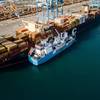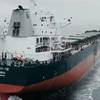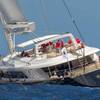LCA Sees Progress on Great Lakes Issues
Prospects for ending the dredging crisis and resolving other pressing issues on the Great Lakes are the best in 12 years according to Lake Carriers’ Association (LCA), the trade association representing U.S.-flag vessel operators on the inland seas, in its State of the Lakes report issued today. Only uniform, Federal regulation of ballast water remains elusive, particularly since Canada has yet to issue its ballast water regulations.
According to LCA, the greatest progress has been made on the dredging crisis. Just a few years ago more than 18 million cubic yards of sediment clogged ports and waterways and the backlog was projected to grow. Now, the backlog is down to approximately 17 million cubic yards and shrinking.
LCA credits passage of the Water Resources Reform and Development Act (WRRDA) of 2014 for turning the tide. The legislation designated the Lakes a system in terms of dredging and directed that expenditures from the Harbor Maintenance Trust Fund be incrementally increased until they reach 100 percent of receipts (in 2025). “Treating the Lakes as a system rather than pitting the 60 Federally maintained deep draft ports against one another for dredging dollars and increased funding should allow the U.S. Army Corps of Engineers to reduce the dredging backlog every year going forward,” declares LCA.
However, the report stresses that the rise in Great Lakes water levels has not restored full loads. The largest single iron ore cargo carried in 2014 totaled 69,859 tons. “The record for the Head-of-the-Lakes trade (Lake Superior to lower Lakes ports) is 72,300 tons, so even the best load of 2014 was still 2,400 tons short of the trade’s benchmark.”
The report repeats LCA’s call for more icebreaking resources on the Great Lakes. “The launch of the new MACKINAW in 2006 ensured we maintained the status quo in terms of a heavy icebreaker, but the following nine years have put a lot of wear and tear on the other icebreakers that have been in service since the late 1970s and early 1980s. Simply put, despite the best efforts of their outstanding crews, the U.S. Coast Guard’s icebreaking assets are now overmatched when nature sends us winters as challenging as the past two.”
Thanks to Great Lakes legislators, Congress has gotten the message, LCA said. The Coast Guard Authorization Act of 2014 passed by the House of Representatives includes provision authored by Congresswoman Candice Miller (R-Mich.) that authorizes the Commandant to design and build a new icebreaker for its Great Lakes Fleet. The Senate FY16 Homeland Security Appropriations bill directs the Coast Guard to conduct a Great Lakes mission analysis within 180 days after its enactment to determine whether another MACKINAW-class icebreaker is required.
LCA then urges the Coast Guard to move quickly once the legislation has been enacted. “The new icebreaker will probably take two years or more to build. Time is of the essence.”
Another project that is time-critical is a second Poe-sized lock at Sault Ste. Marie, Michigan. Eight out of every 10 tons of cargo moving through the Soo Locks transit the Poe Lock, and that chamber is now nearly 50 years old. The project remains stalled by a flawed benefit/cost ratio that mistakenly assumes the railroads could move the cargo if the Poe Lock went down for a lengthy period of time. Thanks to Senator Debbie Stabenow (D-Mich.) and Rep. Dan Benishek (R-Mich.), the Corps is reevaluating the b/c ratio and prospects for twinning the Poe Lock are the best they have been in years.
The report cautions that lack of a Federal standard on ballast water that preempts state regulations and the threat of Canada imposing a transit standard when its ballast water regulations are implemented following ratification of the International Maritime Organization’s ballast water convention “casts a pall” over all the positive news. State regulation of ballast water has created a patchwork of differing requirements.
Most troubling, LCA said, are the yet to be released Canadian ballast water regulations. There is no treatment system that can work on lakers, so a transit standard, which has been endorsed by some in Canada as an option, would ban U.S.-flag lakers from Canadian waters. The problem is U.S.-flag lakers must transit Canadian waters, not only when loading or discharging in Canada, but when trading between U.S. ports. If Canada imposes a transit standard, the U.S.-flag Lakes fleet could be put out of business.
“The State regulation problem could be solved if the Vessel Incidental Discharge Act (VIDA) was enacted. S. 373 sets a uniform and achievable Federal standard. States can suggest more stringent requirements, but they must prove the need and that systems exist that can meet the requirements. The bill also recognizes that vessels that operate within a limited geographic area, such as lakers, do not have the potential to introduce aquatic nuisance species, so requires best management practices rather than treatment.”
The VIDA is still moving through the Senate, both as a stand-alone bill and in the Senate Coast Guard Authorization Act of 2015. The House does not have companion bill right now, but has passed similar legislation in the past.
The ballast water issue notwithstanding, the report concludes that “Great Lakes shipping is on the verge of solving some of its most pressing problems. Challenges will remain, and new ones will appear, but the State of the Lakes in 2015 is proof positive that our efforts, some of which have required years and years of engagement, are paying off, and the future is brighter because of that.”






